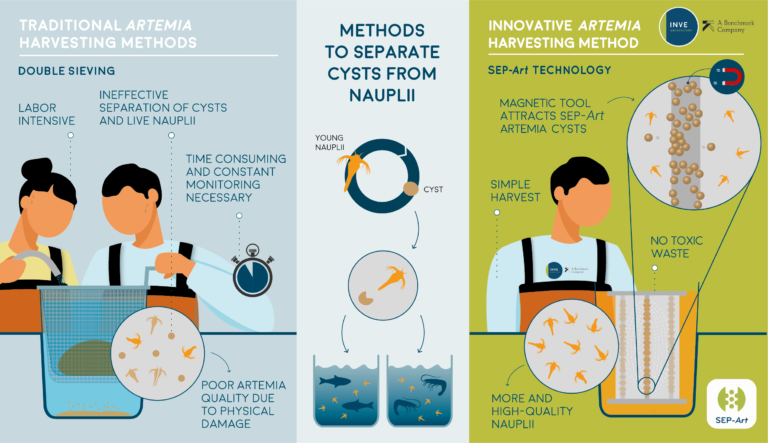To guarantee a consistently high-quality, hatcheries need to respect procedures and provide tools to harvest the Artemia in the most optimal way.
Fish and shrimp hatcheries around the globe rely on Artemia nauplii as the preferred live larval feed to obtain a consistent and predictable production. Artemia triggers the feeding behavior of fish and shrimp larvae, has the appropriate size and is highly nutritious.
Convention but not convenient
During the hatching process, Artemia embryos inside the cysts develop into free-swimming live nauplii that can be found in the hatching tank together with the rigid shells and unhatched cysts. These unhatched cysts and remaining shells are inedible and must be separated from the nauplii before they can be used as feed. The cyst removal is a challenge even to modern aquaculture since the current methods are not always efficient and sustainable. Artemia nauplii are separated from the cysts and shells by using the double-sieving method (Fig. 1). Double sieving is conceptually easy requiring only two superimposed, fine-meshed nets that function as a two-layered filter to separate the cysts from the Artemia nauplii, forcing the nauplii to pass through the mesh. This filtration process is time-consuming and laborious, and it determines the final quality of the live feed.
Additionally, the efficiency of the double-sieving method is influenced by several factors.

A more efficient method
SEP-Art addresses the shortcomings of double-sieving, particularly the suboptimal recovery of biomass and the quality loss of the live feed. SEP-Art uses magnetism to separate Artemia nauplii from their cysts (Fig. 1). Opposed to double sieving, SEP-Art does not employ meshed nets, entirely removing the chance of physical damage to the nauplii. All the nauplii present in the hatching tank can be efficiently recovered. The result is a suspension of very attractive, undamaged and highly active nauplii ready to be fed to the larvae.
More and better quality Artemia nauplii are harvested in less time and with fewer efforts. It increases the efficiency of the process and the quality of Artemia, allowing the upscale of nauplii production to support the sustainable growth of the aquaculture sector.


